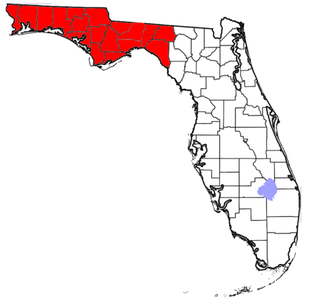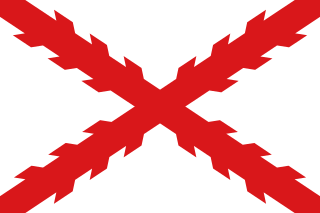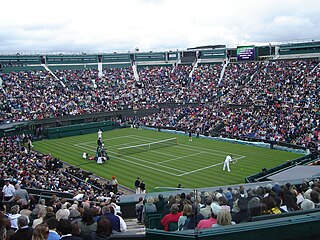Finals
Men's Singles
| Year | Winner | Runner-up | Score |
|---|---|---|---|
| 1882 | | | 4–6, 6–3, 6–4, 7–5 [1] [4] |
| San Gabriel Tournament | |
|---|---|
| Defunct tennis tournament | |
| Founded | 1882 |
| Abolished | 1882 |
| Location | San Gabriel, Palm Coast, Florida, United States |
| Venue | San Gabriel Lawn Tennis Club |
| Surface | Hard |
The San Gabriel Tournament was an American late 19th century men's hard court tennis tournament first staged only one time at San Gabriel, Palm Coast, Florida, United States in June 1882. [1]
The San Gabriel Tournament was a late 19th century tennis men's tennis tournament staged only one known time at San Gabriel, Florida, USA in June 1882. [2] The winner of the men's singles was American player Arthur Allen who defeated Richard Stevens in the final. [3]
| Year | Winner | Runner-up | Score |
|---|---|---|---|
| 1882 | | | 4–6, 6–3, 6–4, 7–5 [1] [4] |

Pensacola is the westernmost city in the Florida Panhandle. It is the county seat and only incorporated city of Escambia County, Florida, United States. At the 2020 census, the population was 54,312. It is the principal city of the Pensacola metropolitan area, which had 509,905 residents in 2020.

West Florida was a region on the northern coast of the Gulf of Mexico that underwent several boundary and sovereignty changes during its history. As its name suggests, it was formed out of the western part of former Spanish Florida, along with lands taken from French Louisiana; Pensacola became West Florida's capital. The colony included about two thirds of what is now the Florida Panhandle, as well as parts of the modern U.S. states of Louisiana, Mississippi, and Alabama.

The Territory of Florida was an organized incorporated territory of the United States that existed from March 30, 1822, until March 3, 1845, when it was admitted to the Union as the State of Florida. Originally the major portion of the Spanish territory of La Florida, and later the provinces of East Florida and West Florida, it was ceded to the United States as part of the 1819 Adams–Onís Treaty. It was governed by the Florida Territorial Council.

Fort Pickens is a pentagonal historic United States military fort on Santa Rosa Island in the Pensacola, Florida, area. It is named after American Revolutionary War hero Andrew Pickens. It is the largest of four forts built to defend Pensacola Bay and its navy yard. The fort was completed in 1834 and was one of the few forts in the South that remained in Union hands throughout the American Civil War. It remained in use until 1947. Fort Pickens is included within the Gulf Islands National Seashore, and as such, is administered by the National Park Service.

John Albert Kramer was an American tennis player of the 1940s and 1950s, and a pioneer promoter who helped drive the sport towards professionalism at the elite level. Kramer also ushered in the serve-and-volley era in tennis, a playing style with which he won three Grand Slam tournaments. He also led the U.S. Davis Cup tennis team to victory in the 1946 and 1947 Davis Cup finals.

The Florida panhandle is the northwestern part of the U.S. state of Florida. It is a salient roughly 200 miles (320 km) long, bordered by Alabama on the north and the west, Georgia on the north, and the Gulf of Mexico to the south. Its eastern boundary is arbitrarily defined. It is defined by its southern culture and rural geography relative to the rest of Florida, as well as closer cultural links to French-influenced Louisiana, Mississippi, and Alabama. Its major communities include Pensacola, Navarre, Destin, Panama City Beach, and Tallahassee.

The Alabama & Gulf Coast Railway is a Class II railroad owned by Genesee & Wyoming. It operates 339 miles (546 km) of track from the Pensacola, Florida export terminals, west of downtown, north to Columbus, Mississippi, with trackage rights along BNSF Railway to Amory, Mississippi. A branch uses trackage rights along Norfolk Southern from Kimbrough, Alabama west and south to Mobile, Alabama, with separate trackage at the end of the line in Mobile.

Naval Air Station Pensacola or NAS Pensacola, "The Cradle of Naval Aviation", is a United States Navy base located next to Warrington, Florida, a community southwest of the Pensacola city limits. It is best known as the initial primary training base for all U.S. Navy, Marine Corps and Coast Guard officers pursuing designation as naval aviators and naval flight officers, the advanced training base for most naval flight officers, and as the home base for the United States Navy Flight Demonstration Squadron, the precision-flying team known as the Blue Angels.

The Apalachee were an Indigenous people of the Southeastern Woodlands, specifically an Indigenous people of Florida, who lived in the Florida Panhandle until the early 18th century. They lived between the Aucilla River and Ochlockonee River, at the head of Apalachee Bay, an area known as the Apalachee Province. They spoke a Muskogean language called Apalachee, which is now extinct.

Robert "Bob" Charles Bryan is an American former doubles world No. 1 tennis player. He won 23 major titles: 16 in men's doubles and 7 in mixed doubles. He turned professional in 1998. With his twin brother Mike, he was the world No. 1 doubles player for several years, first achieving the top ranking in September 2003. The brothers were named the ATP Team of the Decade for 2000–2009. They became the second men's doubles team to complete the career Golden Slam at the 2012 London Olympics.

The siege of Pensacola, fought from March 9 to May 10, 1781, was the culmination of Spain's conquest of West Florida during the Gulf Coast Campaign of the American Revolutionary War.

Spanish Florida was the first major European land-claim and attempted settlement-area in northern America during the European Age of Discovery. La Florida formed part of the Captaincy General of Cuba, the Viceroyalty of New Spain, and the Spanish Empire during Spanish colonization of the Americas. While its boundaries were never clearly or formally defined, the territory was initially much larger than the present-day state of Florida, extending over much of what is now the southeastern United States, including all of present-day Florida plus portions of Georgia, South Carolina, North Carolina, Alabama, Mississippi, and the Florida Parishes of Louisiana. Spain based its claim to this vast area on several wide-ranging expeditions mounted during the 16th century. A number of missions, settlements, and small forts existed in the 16th and to a lesser extent in the 17th century; they were eventually abandoned due to pressure from the expanding English and French colonial settlements, the collapse of the native populations, and the general difficulty in becoming agriculturally or economically self-sufficient. By the 18th century, Spain's control over La Florida did not extend much beyond a handful of forts near St. Augustine, St. Marks, and Pensacola, all within the boundaries of present-day Florida.

The maritime history of Florida describes significant past events relating to the U.S. state of Florida in areas concerning shipping, shipwrecks, and military installations and lighthouses constructed to protect or aid navigation and development of the Florida peninsula.
The history of Pensacola, Florida, begins long before the Spanish claimed founding of the modern city in 1698. The area around present-day Pensacola was inhabited by Native American peoples thousands of years before the historical era.

The racket sport traditionally named lawn tennis, invented in Edgbaston, Birmingham, England, now commonly known simply as tennis, is the direct descendant of what is now denoted real tennis or royal tennis, which continues to be played today as a separate sport with more complex rules. The first Lawn Tennis Club and tournament was held in Royal Leamington Spa on 1 August 1882.
The Surrey Championships also known as the Surrey Grass Court Championships and the Surrey County Championships was a men's and women's international tennis event originally founded in 1882 as the Berrylands Club Tournament. In 1890 the former tournament's name was changed to the Surbiton Open that featured the first Surrey County Championships. The tournament was first played in Richmond then later in Surbiton, Surrey, England on outdoor grass courts. It ran for 73 editions from 1890 to 1981 and after a period of 18 years re-emerged as the Surbiton Trophy.
Richard Stevens was an American tennis player active in the late 19th century and early 20th century, He was a six time singles quarter finalist at the U.S. National Championships. He was active from 1882 to 1916 and won 5 career singles title.

The 1881 men's tennis season was composed of the sixth annual pre-open era tour now incorporated 73 tournaments staged in Australia, Canada, Great Britain and Ireland, and the United States. The 1881 Wimbledon Championships was won by William Renshaw. This year also saw the inaugural and important 1881 U.S. National Championships held at Newport Casino which Richard Sears won. This was also the year that the United States National Lawn Tennis Association, which is the world's first national tennis association, was founded. Renshaw then won two other big tournaments of the year, the Irish Lawn Tennis Championships and Princes Club Championships, whilst Richard Taswell Richardson won the prestigious Northern Championships.
The Fall Open Tournament Far and Near LTC | was a late 19th-century men's grass court tennis tournament held at the Far and Near Lawn Tennis Club in Hastings-on-Hudson, New York, United States. It was part of the Pre-Open era tennis tour from 1883 to 1886.
The New York and District Championships was a men's grass court tennis tournament held at the Staten Island Cricket and Baseball Club, Staten Island, New York City, United States for only two editions in 1882 and 1883.